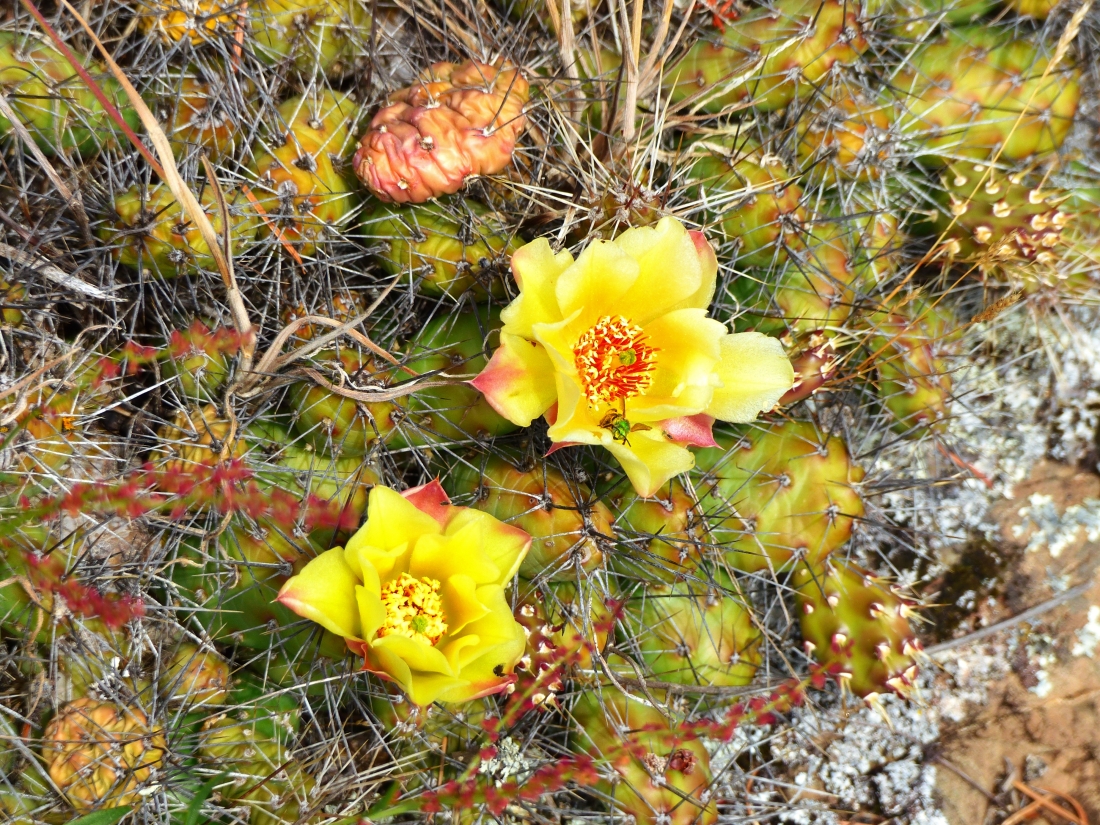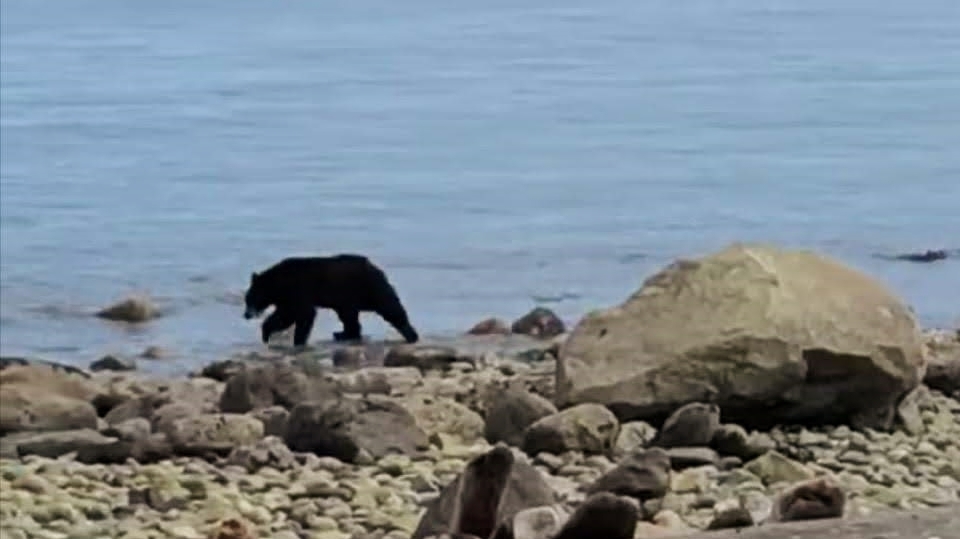 A blooming miracle? Actually, it’s Western Washington’s only native cactus, which prospers in the dry San Juan Islands. Note the green bug investigating the upper flower.
A blooming miracle? Actually, it’s Western Washington’s only native cactus, which prospers in the dry San Juan Islands. Note the green bug investigating the upper flower.
 CACTUS IN MOSSY WESTERN WASHINGTON? Really? Did we take a wrong turn at Albuquerque? Sometimes you just have to go see for yourself.
CACTUS IN MOSSY WESTERN WASHINGTON? Really? Did we take a wrong turn at Albuquerque? Sometimes you just have to go see for yourself.
So the other day we asked fellow islanders Dan and Lisa Lewis if they’d take us over to their favorite beach on neighboring Decatur Island and show us the cactus they insisted existed.
We piled in to their big RIB, which stands for “rigid inflatable boat,” meaning it’s basically a Zodiac but with an aluminum, v-shaped bottom that helps it get up and plane. With a 50-horse Suzuki on the transom it scoots faster than a bird-feeder-raiding raccoon pelted by pine cones.
Barbara packed sandwiches for our exploration party and on the way to the dock we stopped by the Center Island farm stand for a carton of fresh ruby-red strawberries. Sweetest you ever tasted. Strawberries from Monique and Chris Maas’ Center Island farm helped fuel our explorations.
Strawberries from Monique and Chris Maas’ Center Island farm helped fuel our explorations.
In less than 10 minutes from the Center Island dock our friend Dan powered the RIB’s prow up on to a sandy tombolo, a driftwood-strewn, tide-washed isthmus connecting rocky headlands at the south end of Decatur Island. This was the showpiece of San Juan Preservation Trust’s 56-acre Kimball Preserve, set aside in its natural beauty for perpetuity. Looking out on the rushing tidal waters of narrow Lopez Pass and to Rosario Strait beyond, the beach is sheltered by the headlands and can be peaceful even on a windy day.
 Barbara hides behind her sandwich as we lunch with Lisa and Dan Lewis on the tombolo in Kimball Preserve.
Barbara hides behind her sandwich as we lunch with Lisa and Dan Lewis on the tombolo in Kimball Preserve.
We perched on logs and folding chairs and devoured lunch while trading stories, such as the time the Lewises forgot to tie up their RIB here and looked up from a beach log to see their tide-snatched ride disappearing around the point.
That was (unfortunately) also the occasion when they discovered the cactus, as they scrambled in panic to keep their boat in sight. Lisa’s sandaled feet bore the prickly testimony, she recalled with a groan. Eventually, a passing boater returned their RIB, but only after current had sent it shooting out toward the wide waters of Rosario Strait.
After lunch, we went to see the flora phenom. Wandering out on the western headland on an old deer path just above the waterline, we skirted twisted old fir snags that looked to be perfect perches for eagles. Wildflowers slowed me down as I pointed my camera every which way. “There’s a camas flower, the blue one!” I called. “Camas, Washington, was named for it, and Indians used to eat the roots,” I told Lisa and Dan, who formerly lived in the nearby Oregon town of Boring, one of America’s great place names. (My other favorite Oregon town name: Drain, as in “circling the.”)
 Wildflowers abound in Kimball Preserve on Decatur Island.
Wildflowers abound in Kimball Preserve on Decatur Island.
Emerging on rocks bristling with reindeer lichen, Dan and Lisa soon brought us to a wide panorama of water and islands, looking in at Lopez Sound. And at our feet, wide patches of ground-hugging prickly pear cactus.
“And look, this time it’s blooming!” Lisa cried, stepping gingerly.
Sure enough, this was cactus-flower season. Big blossoms of lemon yellow softened the thorny visage of the pincushion-like plant. An unexpected bonus for us Sunday-afternoon explorers.
It was testimony to what we already knew: Thanks to the Olympic Mountains rain-shadow, our island home gets more sun and a lot less rain than drizzly Seattle (about 20 inches per year here, about 36 in the city). Dan and Lisa had stumbled (literally) on a patch of Opuntia fragilis, or brittle prickly pear, the only cactus native to Western Washington. It is found around Sequim, Port Townsend, Whidbey Island and the San Juans. There is actually a small group called the Cactus Islands northwest of us, between Speiden and Johns islands. Be careful landing your inflatable on those little rocks.
Before heading home, Dan pulled out his phone and showed us photos of a bear recently seen nearby on Decatur. It was a rather famous black bear that had swum between islands from Whidbey to Fidalgo to Orcas to San Juan to Lopez to Decatur. It finally swam to the mainland and roved as far as a neighborhood in Mount Vernon, 23 miles away, before being captured June 1 by wildlife officers and transplanted to the North Cascades. Distinctive markings convinced officials it was the same bear. The theory: Yogi was looking for love in all the wrong places.
I think we need that bear for the next Olympics. Sounds like a medalist swimmer to me.
I just hope he’s found a girlfriend after all that looking. ![]()
 A weary black bear walks the beach on Decatur Island after touring the San Juans in a fruitless search for a mate.
A weary black bear walks the beach on Decatur Island after touring the San Juans in a fruitless search for a mate.

Felt like I was there with you . . .great outing from the sounds and looks of it. Cactus, there. Who’d a thunk?
LikeLike